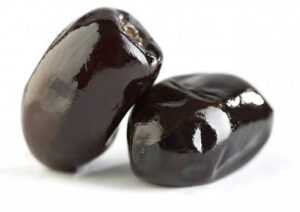Mazafati dates, also known as Bam dates, are a popular variety of dates that originate from Iran. They are known for their unique taste, texture, and nutritional value.
Mazafati dates are soft, juicy, and have a dark brown to black color. They have a sweet and caramel-like flavor with a hint of chocolate. The flesh of the dates is tender and easily separates from the seed.
 Mazafati dates are rich in nutrients, including fiber, potassium, magnesium, and vitamin B6. They are also a good source of antioxidants and have been shown to have anti-inflammatory properties. These dates are often eaten fresh or used in desserts, such as cakes, cookies, and puddings.
Mazafati dates are rich in nutrients, including fiber, potassium, magnesium, and vitamin B6. They are also a good source of antioxidants and have been shown to have anti-inflammatory properties. These dates are often eaten fresh or used in desserts, such as cakes, cookies, and puddings.
They can also be added to smoothies and other beverages for a natural sweetener.
Mazafati dates are typically harvested in August and September and are exported around the world. They are a popular choice for those looking for a healthy and delicious snack, and their unique flavor and texture make them a favorite among date lovers.
The Geography of Mazafati Date
Mazafati dates are primarily grown in the southern region of Iran, particularly in the city of Bam. Bam is located in the Kerman province of Iran, which is known for its hot and dry climate, making it an ideal environment for growing dates.The city of Bam is situated on the edge of the Dasht-e Kavir desert, which is one of the largest deserts in Iran. The surrounding region is characterized by arid landscapes and rocky terrain, with temperatures often exceeding 100 degrees Fahrenheit during the summer months.
Despite the harsh conditions, the region is well-suited for growing dates. The soil in the area is rich in nutrients, and the hot, dry climate is ideal for date palm trees. The region is also home to several natural springs, which provide a reliable source of water for irrigation.
The Mazafati date palm trees are typically grown in small, family-owned orchards throughout the region. The dates are harvested by hand in late August and early September, and are often sold fresh or dried for export to other countries.
Overall, the geographic location of Mazafati dates plays an important role in their unique flavor, texture, and nutritional value. The hot, dry climate and rich soil of the Kerman province provide an ideal environment for growing high-quality dates that are enjoyed by people all over the world.
Properties of Mazafati Dates
Mazafati dates are known for their unique taste, texture, and nutritional properties. Here are some of the key properties of Mazafati dates:1. Nutritional value: Mazafati dates are a rich source of several key nutrients, including fiber, potassium, magnesium, and vitamin B6. They are also high in antioxidants, which can help to protect the body against damage from free radicals.
1. Flavor and texture: Mazafati dates have a rich, sweet taste that is often described as caramel-like, with hints of chocolate. The flesh of the dates is soft and tender, and easily separates from the seed.
2. Health benefits: Mazafati dates are believed to have several health benefits. They may help to regulate blood sugar levels, improve digestion, and boost energy levels.
3. Versatility: Mazafati dates are a versatile ingredient that can be used in a variety of dishes, from desserts and baked goods to smoothies and other beverages.
4. Long shelf life: Mazafati dates have a relatively long shelf life, and can be stored at room temperature for several months. This makes them a convenient and healthy snack option.
Overall, Mazafati dates are a delicious and nutritious type of date that is enjoyed by people all over the world. Their unique flavor, texture, and nutritional properties make them a popular choice for those looking for a healthy and delicious snack.
Harvesting Season of Mazafati Dates
The harvesting season of dates varies depending on the location and the specific variety of date being grown. However, most date varieties are harvested in the late summer or early fall, typically between August and October.

The harvesting process typically involves climbing up the date palm trees to reach the fruit clusters, which can be up to 100 feet off the ground. The fruit clusters are cut down from the trees using long poles, and the dates are then separated from the clusters by hand.
Once the dates have been harvested, they are typically cleaned and sorted to remove any debris or damaged fruit. The dates may also be graded based on their size and quality, and packaged for transport to markets and consumers.
It's worth noting that harvesting dates is a labor-intensive process that requires skilled workers and specialized equipment. In many parts of the world, date harvesting is still done by hand, which can be a slow and challenging process. However, some producers are adopting new technologies and methods to make date harvesting more efficient and sustainable.
Overall, the harvesting season of dates is an important time for date producers and consumers alike. It's a time to celebrate the bounty of the harvest and enjoy the delicious and nutritious fruits of the date palm.
Sorting of Mazafati Dates
Sorting is an important process in the production of Mazafati dates, as it ensures that only high-quality dates are sold to consumers. Here's how sorting typically works:1. Harvesting: Mazafati dates are harvested by hand in late August and early September. The dates are picked when they are fully ripe and have reached their maximum size and sweetness.
2. Cleaning: Once the dates are harvested, they are cleaned to remove any dirt, debris, or insects. This may involve washing the dates with water or using air to blow off any unwanted particles.
3. Sorting: After cleaning, the dates are sorted based on their size, color, and overall quality. This is typically done by hand, with workers carefully inspecting each date to ensure that it meets the desired standards.
4. Grading: Once the dates have been sorted by quality, they may be graded based on their size. This is often done using a machine that sorts the dates into different categories based on their diameter.
5. Packaging: Finally, the sorted and graded dates are packaged for sale. This may involve placing them in bulk containers, retail packaging, or gift packaging, as described earlier.
Overall, sorting is an important part of the production process for Mazafati dates. It helps to ensure that consumers receive high-quality dates that are free from defects and meet the desired standards for size, color, and flavor.
Packaging of Mazafati Dates
The packaging of Mazafati dates can vary depending on the producer and the intended market. Here are some common types of packaging for Mazafati dates:1. Bulk packaging: Mazafati dates are often sold in bulk, either loose or in large bags. This is a common way to purchase dates in markets and grocery stores in Iran and other Middle Eastern countries.
2. Retail packaging: Mazafati dates may also be sold in smaller packages for retail sale. These packages may range in size from a few ounces to several pounds, and may be sold in boxes, bags, or other types of containers.
3. Gift packaging: Mazafati dates are a popular gift item in Iran and other Middle Eastern countries. They may be packaged in decorative boxes or baskets, and may be accompanied by other items such as nuts, dried fruits, or sweets.
Regardless of the type of packaging, it is important that Mazafati dates are stored properly to maintain their quality and freshness. They should be kept in a cool, dry place away from direct sunlight, and should be consumed within a reasonable amount of time after opening.
Transporting of Mazafati Dates
Transporting of Mazafati dates requires careful handling to ensure that the dates reach their destination in good condition. Here are some common practices for transporting Mazafati dates:1. Packaging: Mazafati dates are typically packaged in boxes or bags that are designed to protect the dates during transport. The packaging should be sturdy and able to withstand bumps and jostling during shipment.
2. Temperature control: Mazafati dates are sensitive to temperature and can spoil quickly if they are exposed to extreme heat or cold. During transport, the dates should be kept at a cool, consistent temperature to maintain their quality and freshness.
3. Humidity control: Humidity can also affect the quality of Mazafati dates. During transport, the dates should be kept in a dry environment to prevent them from becoming moist or moldy.
4. Handling: Mazafati dates are delicate and can be easily damaged if they are mishandled during transport. Care should be taken to avoid dropping or crushing the boxes or bags containing the dates.
5. Shipping method: Mazafati dates are often shipped by air or sea, depending on the destination. Air shipping is faster but more expensive, while sea shipping is slower but more cost-effective.
Overall, transporting Mazafati dates requires careful planning and attention to detail to ensure that the dates arrive at their destination in good condition. By following best practices for packaging, temperature control, humidity control, handling, and shipping method, producers can help to ensure that consumers receive high-quality Mazafati dates that are fresh and delicious.

